James Cook University LB5241 Reflective Piece on Leadership
VerifiedAdded on 2023/04/21
|9
|3410
|83
Report
AI Summary
This reflective essay critically analyzes leadership approaches and relates preferred styles with critical leadership. The student reflects on their experiences in group activities and how they have learned about leadership styles and critical theories. The essay presents experiences and critical revelations of studying critical leadership approaches, theories, and styles. The student discusses the differences between leadership and management, the transformational leadership style, and the importance of emotional and cognitive intelligence. The essay also covers the competing values framework and the typological elements of leadership. The student reflects on how their approach to leadership has changed since starting the critical leadership studies and how they plan to apply these learnings in the future.
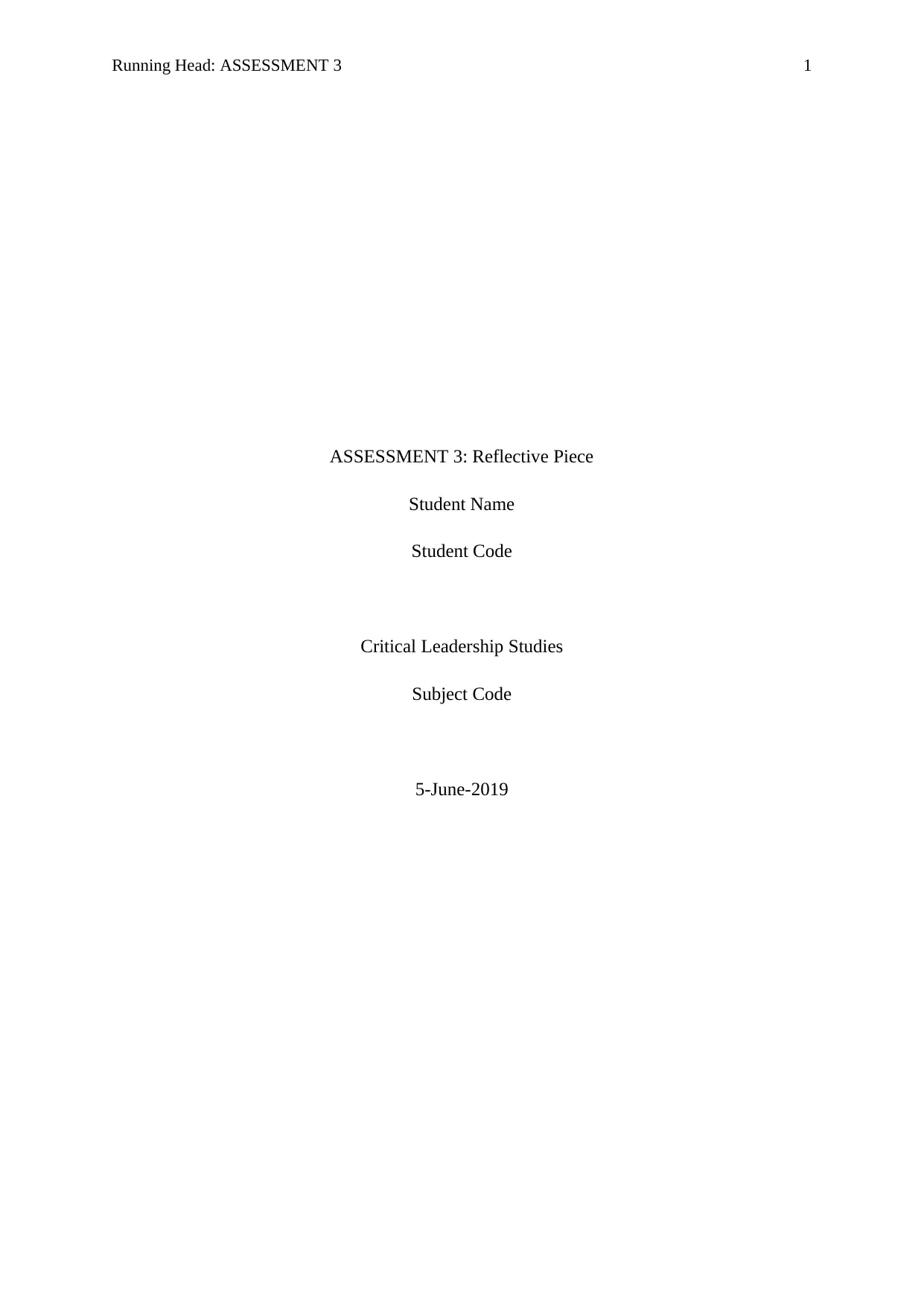
Running Head: ASSESSMENT 3 1
ASSESSMENT 3: Reflective Piece
Student Name
Student Code
Critical Leadership Studies
Subject Code
5-June-2019
ASSESSMENT 3: Reflective Piece
Student Name
Student Code
Critical Leadership Studies
Subject Code
5-June-2019
Paraphrase This Document
Need a fresh take? Get an instant paraphrase of this document with our AI Paraphraser
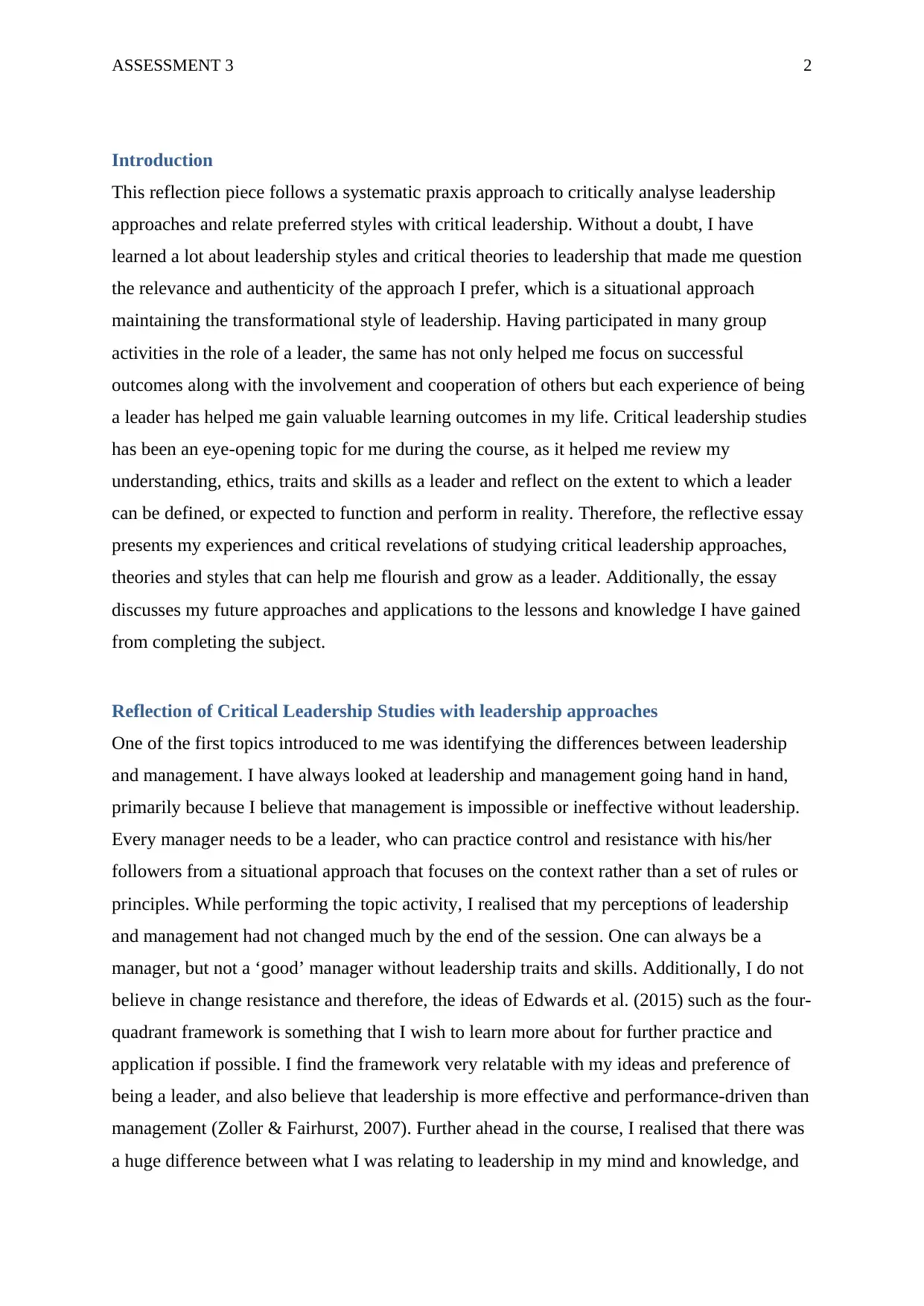
ASSESSMENT 3 2
Introduction
This reflection piece follows a systematic praxis approach to critically analyse leadership
approaches and relate preferred styles with critical leadership. Without a doubt, I have
learned a lot about leadership styles and critical theories to leadership that made me question
the relevance and authenticity of the approach I prefer, which is a situational approach
maintaining the transformational style of leadership. Having participated in many group
activities in the role of a leader, the same has not only helped me focus on successful
outcomes along with the involvement and cooperation of others but each experience of being
a leader has helped me gain valuable learning outcomes in my life. Critical leadership studies
has been an eye-opening topic for me during the course, as it helped me review my
understanding, ethics, traits and skills as a leader and reflect on the extent to which a leader
can be defined, or expected to function and perform in reality. Therefore, the reflective essay
presents my experiences and critical revelations of studying critical leadership approaches,
theories and styles that can help me flourish and grow as a leader. Additionally, the essay
discusses my future approaches and applications to the lessons and knowledge I have gained
from completing the subject.
Reflection of Critical Leadership Studies with leadership approaches
One of the first topics introduced to me was identifying the differences between leadership
and management. I have always looked at leadership and management going hand in hand,
primarily because I believe that management is impossible or ineffective without leadership.
Every manager needs to be a leader, who can practice control and resistance with his/her
followers from a situational approach that focuses on the context rather than a set of rules or
principles. While performing the topic activity, I realised that my perceptions of leadership
and management had not changed much by the end of the session. One can always be a
manager, but not a ‘good’ manager without leadership traits and skills. Additionally, I do not
believe in change resistance and therefore, the ideas of Edwards et al. (2015) such as the four-
quadrant framework is something that I wish to learn more about for further practice and
application if possible. I find the framework very relatable with my ideas and preference of
being a leader, and also believe that leadership is more effective and performance-driven than
management (Zoller & Fairhurst, 2007). Further ahead in the course, I realised that there was
a huge difference between what I was relating to leadership in my mind and knowledge, and
Introduction
This reflection piece follows a systematic praxis approach to critically analyse leadership
approaches and relate preferred styles with critical leadership. Without a doubt, I have
learned a lot about leadership styles and critical theories to leadership that made me question
the relevance and authenticity of the approach I prefer, which is a situational approach
maintaining the transformational style of leadership. Having participated in many group
activities in the role of a leader, the same has not only helped me focus on successful
outcomes along with the involvement and cooperation of others but each experience of being
a leader has helped me gain valuable learning outcomes in my life. Critical leadership studies
has been an eye-opening topic for me during the course, as it helped me review my
understanding, ethics, traits and skills as a leader and reflect on the extent to which a leader
can be defined, or expected to function and perform in reality. Therefore, the reflective essay
presents my experiences and critical revelations of studying critical leadership approaches,
theories and styles that can help me flourish and grow as a leader. Additionally, the essay
discusses my future approaches and applications to the lessons and knowledge I have gained
from completing the subject.
Reflection of Critical Leadership Studies with leadership approaches
One of the first topics introduced to me was identifying the differences between leadership
and management. I have always looked at leadership and management going hand in hand,
primarily because I believe that management is impossible or ineffective without leadership.
Every manager needs to be a leader, who can practice control and resistance with his/her
followers from a situational approach that focuses on the context rather than a set of rules or
principles. While performing the topic activity, I realised that my perceptions of leadership
and management had not changed much by the end of the session. One can always be a
manager, but not a ‘good’ manager without leadership traits and skills. Additionally, I do not
believe in change resistance and therefore, the ideas of Edwards et al. (2015) such as the four-
quadrant framework is something that I wish to learn more about for further practice and
application if possible. I find the framework very relatable with my ideas and preference of
being a leader, and also believe that leadership is more effective and performance-driven than
management (Zoller & Fairhurst, 2007). Further ahead in the course, I realised that there was
a huge difference between what I was relating to leadership in my mind and knowledge, and
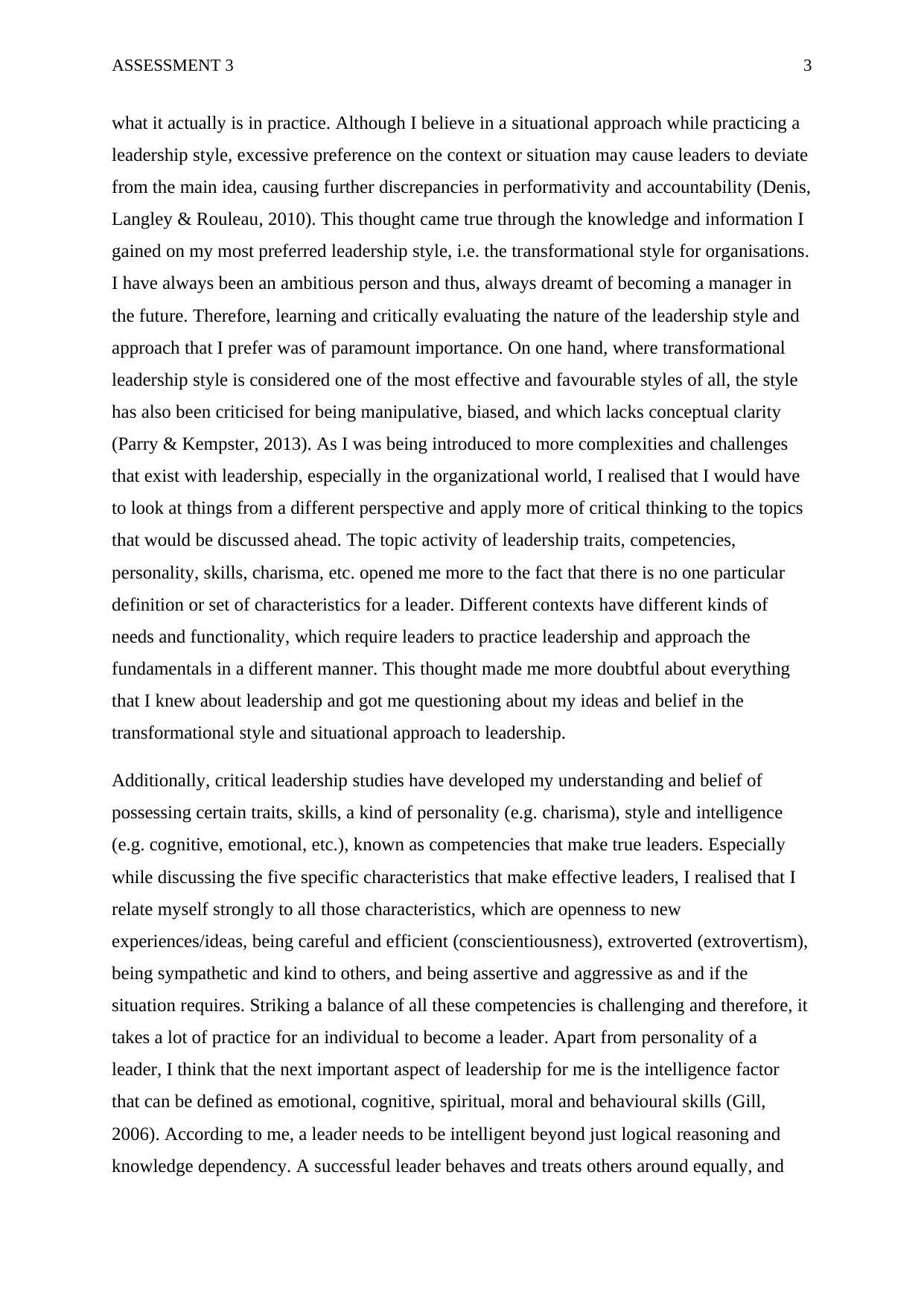
ASSESSMENT 3 3
what it actually is in practice. Although I believe in a situational approach while practicing a
leadership style, excessive preference on the context or situation may cause leaders to deviate
from the main idea, causing further discrepancies in performativity and accountability (Denis,
Langley & Rouleau, 2010). This thought came true through the knowledge and information I
gained on my most preferred leadership style, i.e. the transformational style for organisations.
I have always been an ambitious person and thus, always dreamt of becoming a manager in
the future. Therefore, learning and critically evaluating the nature of the leadership style and
approach that I prefer was of paramount importance. On one hand, where transformational
leadership style is considered one of the most effective and favourable styles of all, the style
has also been criticised for being manipulative, biased, and which lacks conceptual clarity
(Parry & Kempster, 2013). As I was being introduced to more complexities and challenges
that exist with leadership, especially in the organizational world, I realised that I would have
to look at things from a different perspective and apply more of critical thinking to the topics
that would be discussed ahead. The topic activity of leadership traits, competencies,
personality, skills, charisma, etc. opened me more to the fact that there is no one particular
definition or set of characteristics for a leader. Different contexts have different kinds of
needs and functionality, which require leaders to practice leadership and approach the
fundamentals in a different manner. This thought made me more doubtful about everything
that I knew about leadership and got me questioning about my ideas and belief in the
transformational style and situational approach to leadership.
Additionally, critical leadership studies have developed my understanding and belief of
possessing certain traits, skills, a kind of personality (e.g. charisma), style and intelligence
(e.g. cognitive, emotional, etc.), known as competencies that make true leaders. Especially
while discussing the five specific characteristics that make effective leaders, I realised that I
relate myself strongly to all those characteristics, which are openness to new
experiences/ideas, being careful and efficient (conscientiousness), extroverted (extrovertism),
being sympathetic and kind to others, and being assertive and aggressive as and if the
situation requires. Striking a balance of all these competencies is challenging and therefore, it
takes a lot of practice for an individual to become a leader. Apart from personality of a
leader, I think that the next important aspect of leadership for me is the intelligence factor
that can be defined as emotional, cognitive, spiritual, moral and behavioural skills (Gill,
2006). According to me, a leader needs to be intelligent beyond just logical reasoning and
knowledge dependency. A successful leader behaves and treats others around equally, and
what it actually is in practice. Although I believe in a situational approach while practicing a
leadership style, excessive preference on the context or situation may cause leaders to deviate
from the main idea, causing further discrepancies in performativity and accountability (Denis,
Langley & Rouleau, 2010). This thought came true through the knowledge and information I
gained on my most preferred leadership style, i.e. the transformational style for organisations.
I have always been an ambitious person and thus, always dreamt of becoming a manager in
the future. Therefore, learning and critically evaluating the nature of the leadership style and
approach that I prefer was of paramount importance. On one hand, where transformational
leadership style is considered one of the most effective and favourable styles of all, the style
has also been criticised for being manipulative, biased, and which lacks conceptual clarity
(Parry & Kempster, 2013). As I was being introduced to more complexities and challenges
that exist with leadership, especially in the organizational world, I realised that I would have
to look at things from a different perspective and apply more of critical thinking to the topics
that would be discussed ahead. The topic activity of leadership traits, competencies,
personality, skills, charisma, etc. opened me more to the fact that there is no one particular
definition or set of characteristics for a leader. Different contexts have different kinds of
needs and functionality, which require leaders to practice leadership and approach the
fundamentals in a different manner. This thought made me more doubtful about everything
that I knew about leadership and got me questioning about my ideas and belief in the
transformational style and situational approach to leadership.
Additionally, critical leadership studies have developed my understanding and belief of
possessing certain traits, skills, a kind of personality (e.g. charisma), style and intelligence
(e.g. cognitive, emotional, etc.), known as competencies that make true leaders. Especially
while discussing the five specific characteristics that make effective leaders, I realised that I
relate myself strongly to all those characteristics, which are openness to new
experiences/ideas, being careful and efficient (conscientiousness), extroverted (extrovertism),
being sympathetic and kind to others, and being assertive and aggressive as and if the
situation requires. Striking a balance of all these competencies is challenging and therefore, it
takes a lot of practice for an individual to become a leader. Apart from personality of a
leader, I think that the next important aspect of leadership for me is the intelligence factor
that can be defined as emotional, cognitive, spiritual, moral and behavioural skills (Gill,
2006). According to me, a leader needs to be intelligent beyond just logical reasoning and
knowledge dependency. A successful leader behaves and treats others around equally, and
⊘ This is a preview!⊘
Do you want full access?
Subscribe today to unlock all pages.

Trusted by 1+ million students worldwide
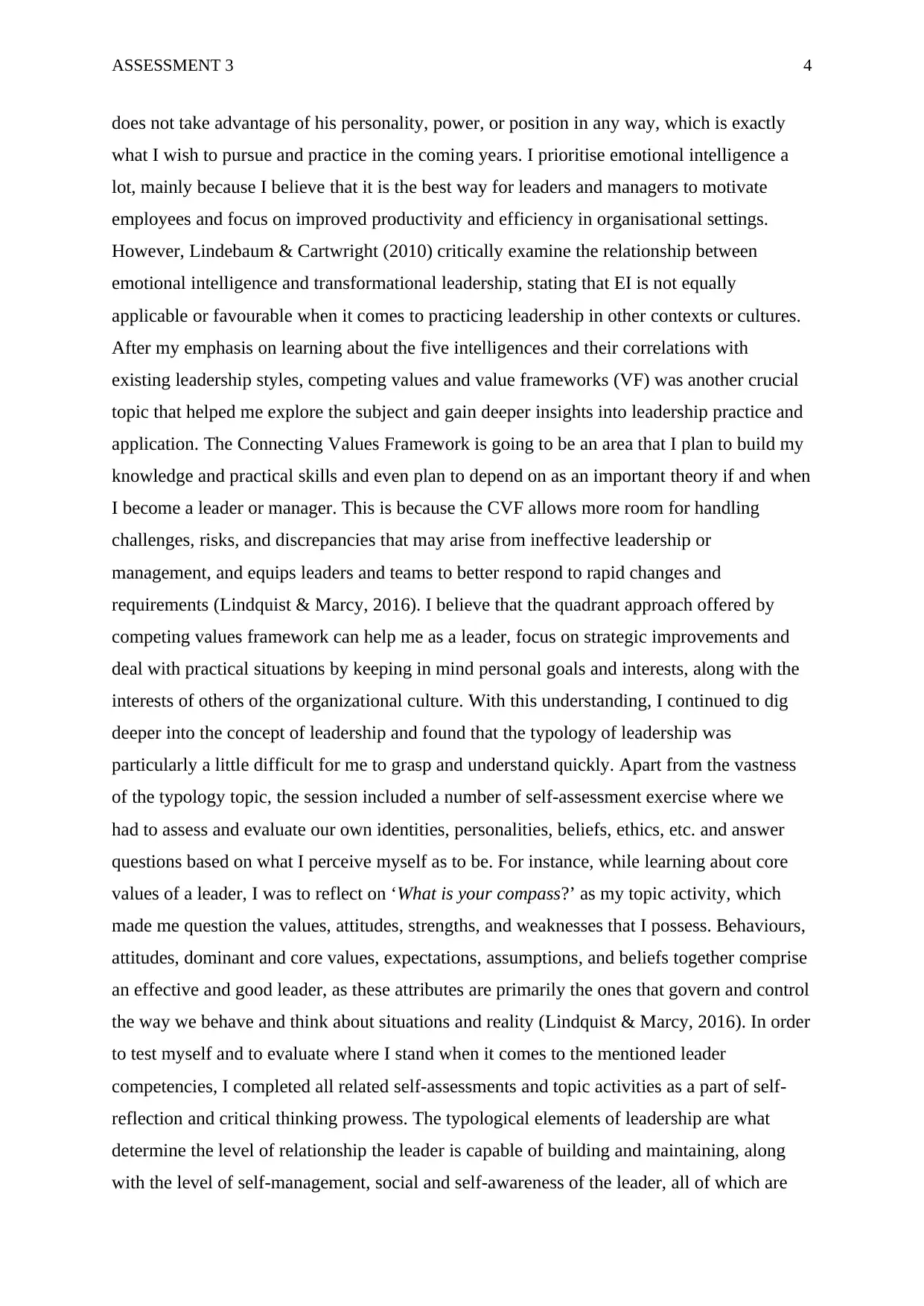
ASSESSMENT 3 4
does not take advantage of his personality, power, or position in any way, which is exactly
what I wish to pursue and practice in the coming years. I prioritise emotional intelligence a
lot, mainly because I believe that it is the best way for leaders and managers to motivate
employees and focus on improved productivity and efficiency in organisational settings.
However, Lindebaum & Cartwright (2010) critically examine the relationship between
emotional intelligence and transformational leadership, stating that EI is not equally
applicable or favourable when it comes to practicing leadership in other contexts or cultures.
After my emphasis on learning about the five intelligences and their correlations with
existing leadership styles, competing values and value frameworks (VF) was another crucial
topic that helped me explore the subject and gain deeper insights into leadership practice and
application. The Connecting Values Framework is going to be an area that I plan to build my
knowledge and practical skills and even plan to depend on as an important theory if and when
I become a leader or manager. This is because the CVF allows more room for handling
challenges, risks, and discrepancies that may arise from ineffective leadership or
management, and equips leaders and teams to better respond to rapid changes and
requirements (Lindquist & Marcy, 2016). I believe that the quadrant approach offered by
competing values framework can help me as a leader, focus on strategic improvements and
deal with practical situations by keeping in mind personal goals and interests, along with the
interests of others of the organizational culture. With this understanding, I continued to dig
deeper into the concept of leadership and found that the typology of leadership was
particularly a little difficult for me to grasp and understand quickly. Apart from the vastness
of the typology topic, the session included a number of self-assessment exercise where we
had to assess and evaluate our own identities, personalities, beliefs, ethics, etc. and answer
questions based on what I perceive myself as to be. For instance, while learning about core
values of a leader, I was to reflect on ‘What is your compass?’ as my topic activity, which
made me question the values, attitudes, strengths, and weaknesses that I possess. Behaviours,
attitudes, dominant and core values, expectations, assumptions, and beliefs together comprise
an effective and good leader, as these attributes are primarily the ones that govern and control
the way we behave and think about situations and reality (Lindquist & Marcy, 2016). In order
to test myself and to evaluate where I stand when it comes to the mentioned leader
competencies, I completed all related self-assessments and topic activities as a part of self-
reflection and critical thinking prowess. The typological elements of leadership are what
determine the level of relationship the leader is capable of building and maintaining, along
with the level of self-management, social and self-awareness of the leader, all of which are
does not take advantage of his personality, power, or position in any way, which is exactly
what I wish to pursue and practice in the coming years. I prioritise emotional intelligence a
lot, mainly because I believe that it is the best way for leaders and managers to motivate
employees and focus on improved productivity and efficiency in organisational settings.
However, Lindebaum & Cartwright (2010) critically examine the relationship between
emotional intelligence and transformational leadership, stating that EI is not equally
applicable or favourable when it comes to practicing leadership in other contexts or cultures.
After my emphasis on learning about the five intelligences and their correlations with
existing leadership styles, competing values and value frameworks (VF) was another crucial
topic that helped me explore the subject and gain deeper insights into leadership practice and
application. The Connecting Values Framework is going to be an area that I plan to build my
knowledge and practical skills and even plan to depend on as an important theory if and when
I become a leader or manager. This is because the CVF allows more room for handling
challenges, risks, and discrepancies that may arise from ineffective leadership or
management, and equips leaders and teams to better respond to rapid changes and
requirements (Lindquist & Marcy, 2016). I believe that the quadrant approach offered by
competing values framework can help me as a leader, focus on strategic improvements and
deal with practical situations by keeping in mind personal goals and interests, along with the
interests of others of the organizational culture. With this understanding, I continued to dig
deeper into the concept of leadership and found that the typology of leadership was
particularly a little difficult for me to grasp and understand quickly. Apart from the vastness
of the typology topic, the session included a number of self-assessment exercise where we
had to assess and evaluate our own identities, personalities, beliefs, ethics, etc. and answer
questions based on what I perceive myself as to be. For instance, while learning about core
values of a leader, I was to reflect on ‘What is your compass?’ as my topic activity, which
made me question the values, attitudes, strengths, and weaknesses that I possess. Behaviours,
attitudes, dominant and core values, expectations, assumptions, and beliefs together comprise
an effective and good leader, as these attributes are primarily the ones that govern and control
the way we behave and think about situations and reality (Lindquist & Marcy, 2016). In order
to test myself and to evaluate where I stand when it comes to the mentioned leader
competencies, I completed all related self-assessments and topic activities as a part of self-
reflection and critical thinking prowess. The typological elements of leadership are what
determine the level of relationship the leader is capable of building and maintaining, along
with the level of self-management, social and self-awareness of the leader, all of which are
Paraphrase This Document
Need a fresh take? Get an instant paraphrase of this document with our AI Paraphraser
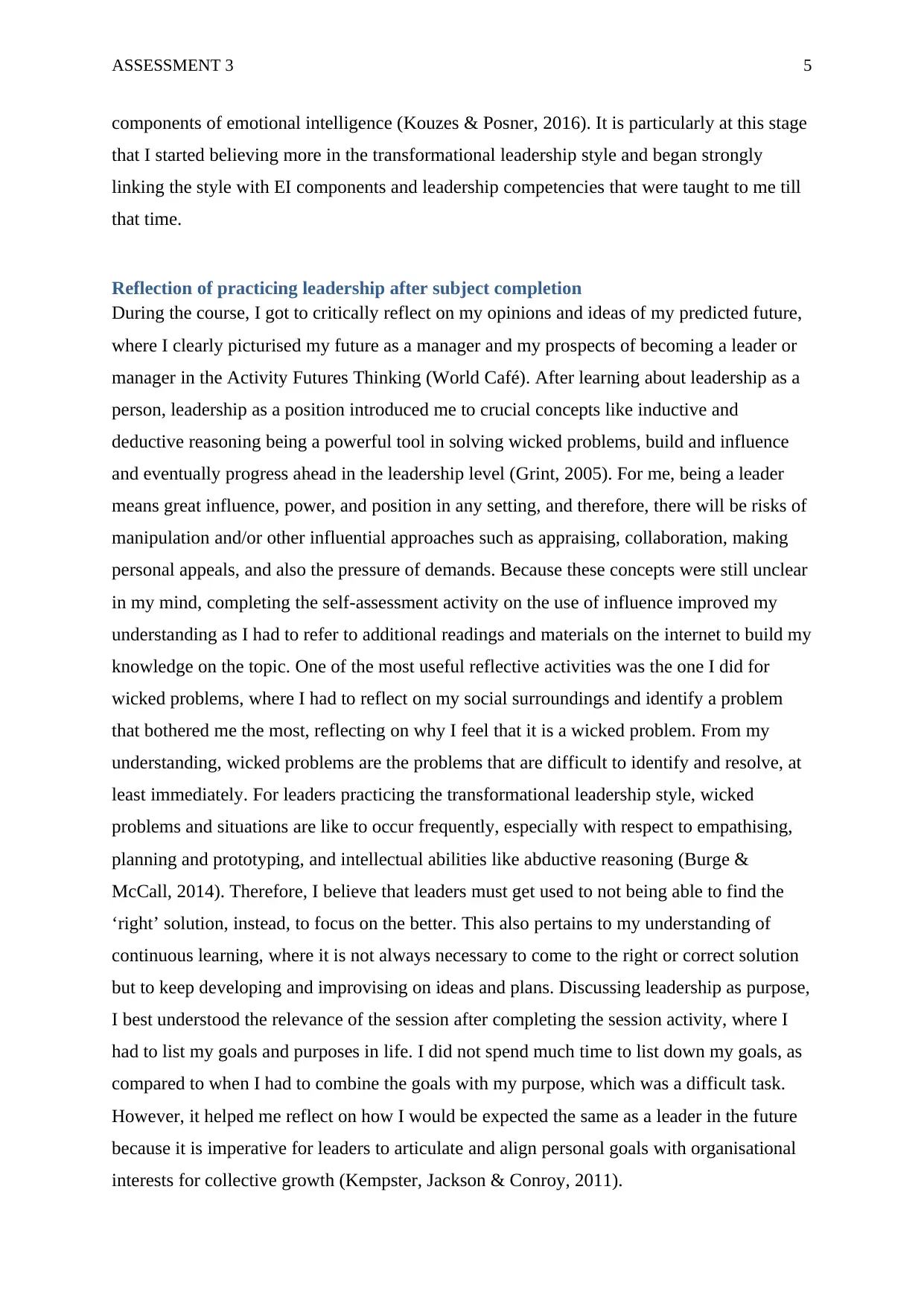
ASSESSMENT 3 5
components of emotional intelligence (Kouzes & Posner, 2016). It is particularly at this stage
that I started believing more in the transformational leadership style and began strongly
linking the style with EI components and leadership competencies that were taught to me till
that time.
Reflection of practicing leadership after subject completion
During the course, I got to critically reflect on my opinions and ideas of my predicted future,
where I clearly picturised my future as a manager and my prospects of becoming a leader or
manager in the Activity Futures Thinking (World Café). After learning about leadership as a
person, leadership as a position introduced me to crucial concepts like inductive and
deductive reasoning being a powerful tool in solving wicked problems, build and influence
and eventually progress ahead in the leadership level (Grint, 2005). For me, being a leader
means great influence, power, and position in any setting, and therefore, there will be risks of
manipulation and/or other influential approaches such as appraising, collaboration, making
personal appeals, and also the pressure of demands. Because these concepts were still unclear
in my mind, completing the self-assessment activity on the use of influence improved my
understanding as I had to refer to additional readings and materials on the internet to build my
knowledge on the topic. One of the most useful reflective activities was the one I did for
wicked problems, where I had to reflect on my social surroundings and identify a problem
that bothered me the most, reflecting on why I feel that it is a wicked problem. From my
understanding, wicked problems are the problems that are difficult to identify and resolve, at
least immediately. For leaders practicing the transformational leadership style, wicked
problems and situations are like to occur frequently, especially with respect to empathising,
planning and prototyping, and intellectual abilities like abductive reasoning (Burge &
McCall, 2014). Therefore, I believe that leaders must get used to not being able to find the
‘right’ solution, instead, to focus on the better. This also pertains to my understanding of
continuous learning, where it is not always necessary to come to the right or correct solution
but to keep developing and improvising on ideas and plans. Discussing leadership as purpose,
I best understood the relevance of the session after completing the session activity, where I
had to list my goals and purposes in life. I did not spend much time to list down my goals, as
compared to when I had to combine the goals with my purpose, which was a difficult task.
However, it helped me reflect on how I would be expected the same as a leader in the future
because it is imperative for leaders to articulate and align personal goals with organisational
interests for collective growth (Kempster, Jackson & Conroy, 2011).
components of emotional intelligence (Kouzes & Posner, 2016). It is particularly at this stage
that I started believing more in the transformational leadership style and began strongly
linking the style with EI components and leadership competencies that were taught to me till
that time.
Reflection of practicing leadership after subject completion
During the course, I got to critically reflect on my opinions and ideas of my predicted future,
where I clearly picturised my future as a manager and my prospects of becoming a leader or
manager in the Activity Futures Thinking (World Café). After learning about leadership as a
person, leadership as a position introduced me to crucial concepts like inductive and
deductive reasoning being a powerful tool in solving wicked problems, build and influence
and eventually progress ahead in the leadership level (Grint, 2005). For me, being a leader
means great influence, power, and position in any setting, and therefore, there will be risks of
manipulation and/or other influential approaches such as appraising, collaboration, making
personal appeals, and also the pressure of demands. Because these concepts were still unclear
in my mind, completing the self-assessment activity on the use of influence improved my
understanding as I had to refer to additional readings and materials on the internet to build my
knowledge on the topic. One of the most useful reflective activities was the one I did for
wicked problems, where I had to reflect on my social surroundings and identify a problem
that bothered me the most, reflecting on why I feel that it is a wicked problem. From my
understanding, wicked problems are the problems that are difficult to identify and resolve, at
least immediately. For leaders practicing the transformational leadership style, wicked
problems and situations are like to occur frequently, especially with respect to empathising,
planning and prototyping, and intellectual abilities like abductive reasoning (Burge &
McCall, 2014). Therefore, I believe that leaders must get used to not being able to find the
‘right’ solution, instead, to focus on the better. This also pertains to my understanding of
continuous learning, where it is not always necessary to come to the right or correct solution
but to keep developing and improvising on ideas and plans. Discussing leadership as purpose,
I best understood the relevance of the session after completing the session activity, where I
had to list my goals and purposes in life. I did not spend much time to list down my goals, as
compared to when I had to combine the goals with my purpose, which was a difficult task.
However, it helped me reflect on how I would be expected the same as a leader in the future
because it is imperative for leaders to articulate and align personal goals with organisational
interests for collective growth (Kempster, Jackson & Conroy, 2011).
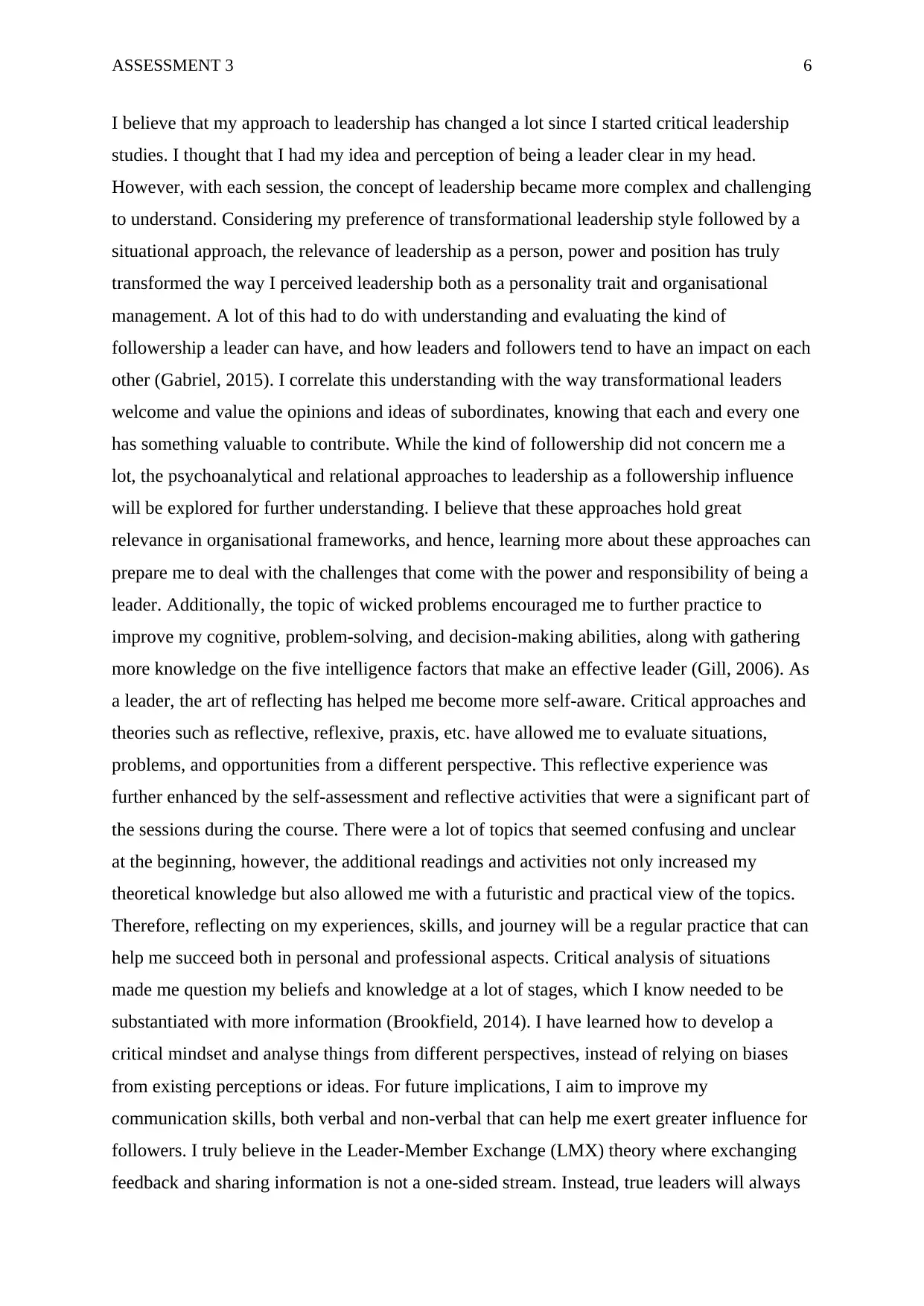
ASSESSMENT 3 6
I believe that my approach to leadership has changed a lot since I started critical leadership
studies. I thought that I had my idea and perception of being a leader clear in my head.
However, with each session, the concept of leadership became more complex and challenging
to understand. Considering my preference of transformational leadership style followed by a
situational approach, the relevance of leadership as a person, power and position has truly
transformed the way I perceived leadership both as a personality trait and organisational
management. A lot of this had to do with understanding and evaluating the kind of
followership a leader can have, and how leaders and followers tend to have an impact on each
other (Gabriel, 2015). I correlate this understanding with the way transformational leaders
welcome and value the opinions and ideas of subordinates, knowing that each and every one
has something valuable to contribute. While the kind of followership did not concern me a
lot, the psychoanalytical and relational approaches to leadership as a followership influence
will be explored for further understanding. I believe that these approaches hold great
relevance in organisational frameworks, and hence, learning more about these approaches can
prepare me to deal with the challenges that come with the power and responsibility of being a
leader. Additionally, the topic of wicked problems encouraged me to further practice to
improve my cognitive, problem-solving, and decision-making abilities, along with gathering
more knowledge on the five intelligence factors that make an effective leader (Gill, 2006). As
a leader, the art of reflecting has helped me become more self-aware. Critical approaches and
theories such as reflective, reflexive, praxis, etc. have allowed me to evaluate situations,
problems, and opportunities from a different perspective. This reflective experience was
further enhanced by the self-assessment and reflective activities that were a significant part of
the sessions during the course. There were a lot of topics that seemed confusing and unclear
at the beginning, however, the additional readings and activities not only increased my
theoretical knowledge but also allowed me with a futuristic and practical view of the topics.
Therefore, reflecting on my experiences, skills, and journey will be a regular practice that can
help me succeed both in personal and professional aspects. Critical analysis of situations
made me question my beliefs and knowledge at a lot of stages, which I know needed to be
substantiated with more information (Brookfield, 2014). I have learned how to develop a
critical mindset and analyse things from different perspectives, instead of relying on biases
from existing perceptions or ideas. For future implications, I aim to improve my
communication skills, both verbal and non-verbal that can help me exert greater influence for
followers. I truly believe in the Leader-Member Exchange (LMX) theory where exchanging
feedback and sharing information is not a one-sided stream. Instead, true leaders will always
I believe that my approach to leadership has changed a lot since I started critical leadership
studies. I thought that I had my idea and perception of being a leader clear in my head.
However, with each session, the concept of leadership became more complex and challenging
to understand. Considering my preference of transformational leadership style followed by a
situational approach, the relevance of leadership as a person, power and position has truly
transformed the way I perceived leadership both as a personality trait and organisational
management. A lot of this had to do with understanding and evaluating the kind of
followership a leader can have, and how leaders and followers tend to have an impact on each
other (Gabriel, 2015). I correlate this understanding with the way transformational leaders
welcome and value the opinions and ideas of subordinates, knowing that each and every one
has something valuable to contribute. While the kind of followership did not concern me a
lot, the psychoanalytical and relational approaches to leadership as a followership influence
will be explored for further understanding. I believe that these approaches hold great
relevance in organisational frameworks, and hence, learning more about these approaches can
prepare me to deal with the challenges that come with the power and responsibility of being a
leader. Additionally, the topic of wicked problems encouraged me to further practice to
improve my cognitive, problem-solving, and decision-making abilities, along with gathering
more knowledge on the five intelligence factors that make an effective leader (Gill, 2006). As
a leader, the art of reflecting has helped me become more self-aware. Critical approaches and
theories such as reflective, reflexive, praxis, etc. have allowed me to evaluate situations,
problems, and opportunities from a different perspective. This reflective experience was
further enhanced by the self-assessment and reflective activities that were a significant part of
the sessions during the course. There were a lot of topics that seemed confusing and unclear
at the beginning, however, the additional readings and activities not only increased my
theoretical knowledge but also allowed me with a futuristic and practical view of the topics.
Therefore, reflecting on my experiences, skills, and journey will be a regular practice that can
help me succeed both in personal and professional aspects. Critical analysis of situations
made me question my beliefs and knowledge at a lot of stages, which I know needed to be
substantiated with more information (Brookfield, 2014). I have learned how to develop a
critical mindset and analyse things from different perspectives, instead of relying on biases
from existing perceptions or ideas. For future implications, I aim to improve my
communication skills, both verbal and non-verbal that can help me exert greater influence for
followers. I truly believe in the Leader-Member Exchange (LMX) theory where exchanging
feedback and sharing information is not a one-sided stream. Instead, true leaders will always
⊘ This is a preview!⊘
Do you want full access?
Subscribe today to unlock all pages.

Trusted by 1+ million students worldwide
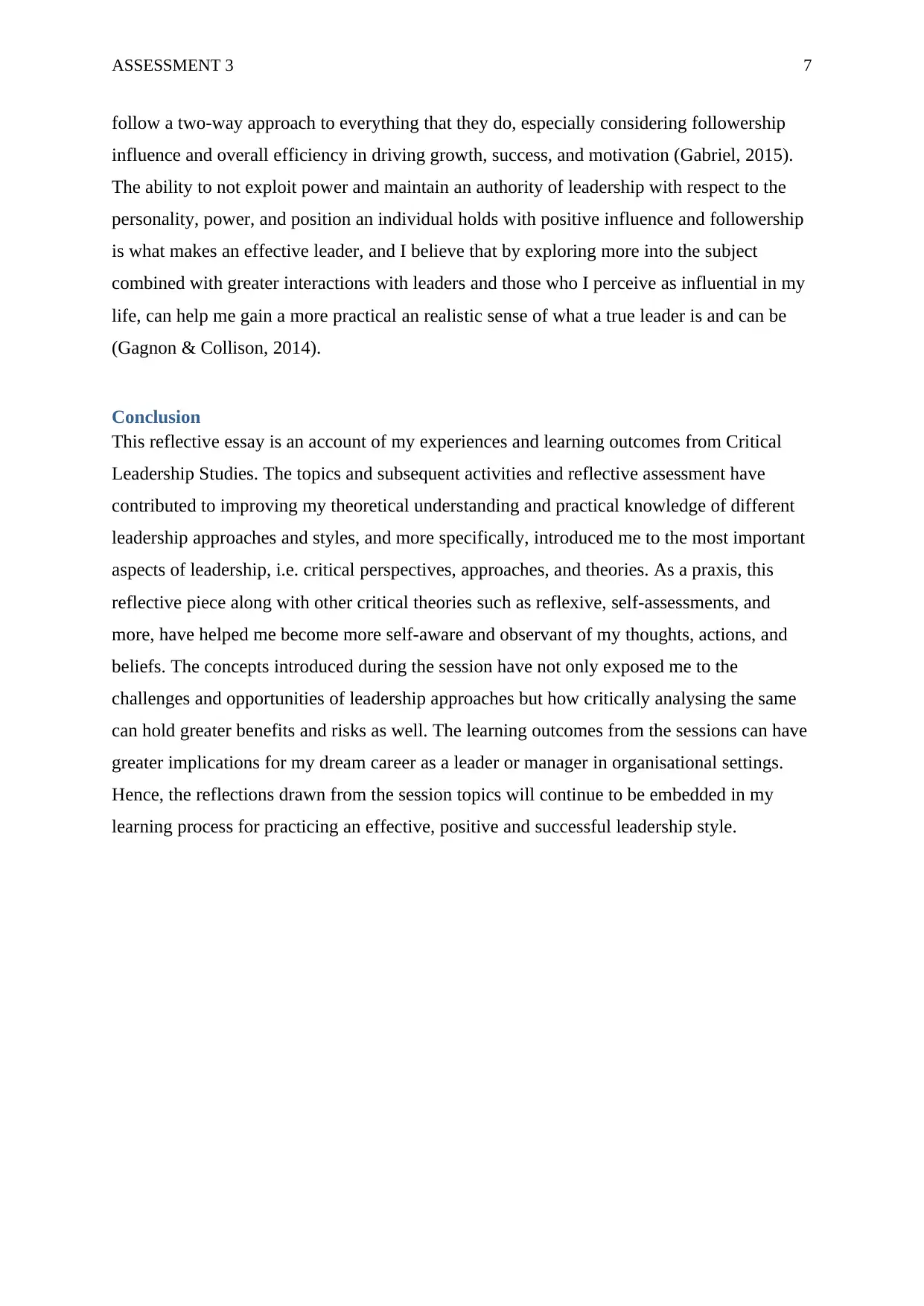
ASSESSMENT 3 7
follow a two-way approach to everything that they do, especially considering followership
influence and overall efficiency in driving growth, success, and motivation (Gabriel, 2015).
The ability to not exploit power and maintain an authority of leadership with respect to the
personality, power, and position an individual holds with positive influence and followership
is what makes an effective leader, and I believe that by exploring more into the subject
combined with greater interactions with leaders and those who I perceive as influential in my
life, can help me gain a more practical an realistic sense of what a true leader is and can be
(Gagnon & Collison, 2014).
Conclusion
This reflective essay is an account of my experiences and learning outcomes from Critical
Leadership Studies. The topics and subsequent activities and reflective assessment have
contributed to improving my theoretical understanding and practical knowledge of different
leadership approaches and styles, and more specifically, introduced me to the most important
aspects of leadership, i.e. critical perspectives, approaches, and theories. As a praxis, this
reflective piece along with other critical theories such as reflexive, self-assessments, and
more, have helped me become more self-aware and observant of my thoughts, actions, and
beliefs. The concepts introduced during the session have not only exposed me to the
challenges and opportunities of leadership approaches but how critically analysing the same
can hold greater benefits and risks as well. The learning outcomes from the sessions can have
greater implications for my dream career as a leader or manager in organisational settings.
Hence, the reflections drawn from the session topics will continue to be embedded in my
learning process for practicing an effective, positive and successful leadership style.
follow a two-way approach to everything that they do, especially considering followership
influence and overall efficiency in driving growth, success, and motivation (Gabriel, 2015).
The ability to not exploit power and maintain an authority of leadership with respect to the
personality, power, and position an individual holds with positive influence and followership
is what makes an effective leader, and I believe that by exploring more into the subject
combined with greater interactions with leaders and those who I perceive as influential in my
life, can help me gain a more practical an realistic sense of what a true leader is and can be
(Gagnon & Collison, 2014).
Conclusion
This reflective essay is an account of my experiences and learning outcomes from Critical
Leadership Studies. The topics and subsequent activities and reflective assessment have
contributed to improving my theoretical understanding and practical knowledge of different
leadership approaches and styles, and more specifically, introduced me to the most important
aspects of leadership, i.e. critical perspectives, approaches, and theories. As a praxis, this
reflective piece along with other critical theories such as reflexive, self-assessments, and
more, have helped me become more self-aware and observant of my thoughts, actions, and
beliefs. The concepts introduced during the session have not only exposed me to the
challenges and opportunities of leadership approaches but how critically analysing the same
can hold greater benefits and risks as well. The learning outcomes from the sessions can have
greater implications for my dream career as a leader or manager in organisational settings.
Hence, the reflections drawn from the session topics will continue to be embedded in my
learning process for practicing an effective, positive and successful leadership style.
Paraphrase This Document
Need a fresh take? Get an instant paraphrase of this document with our AI Paraphraser
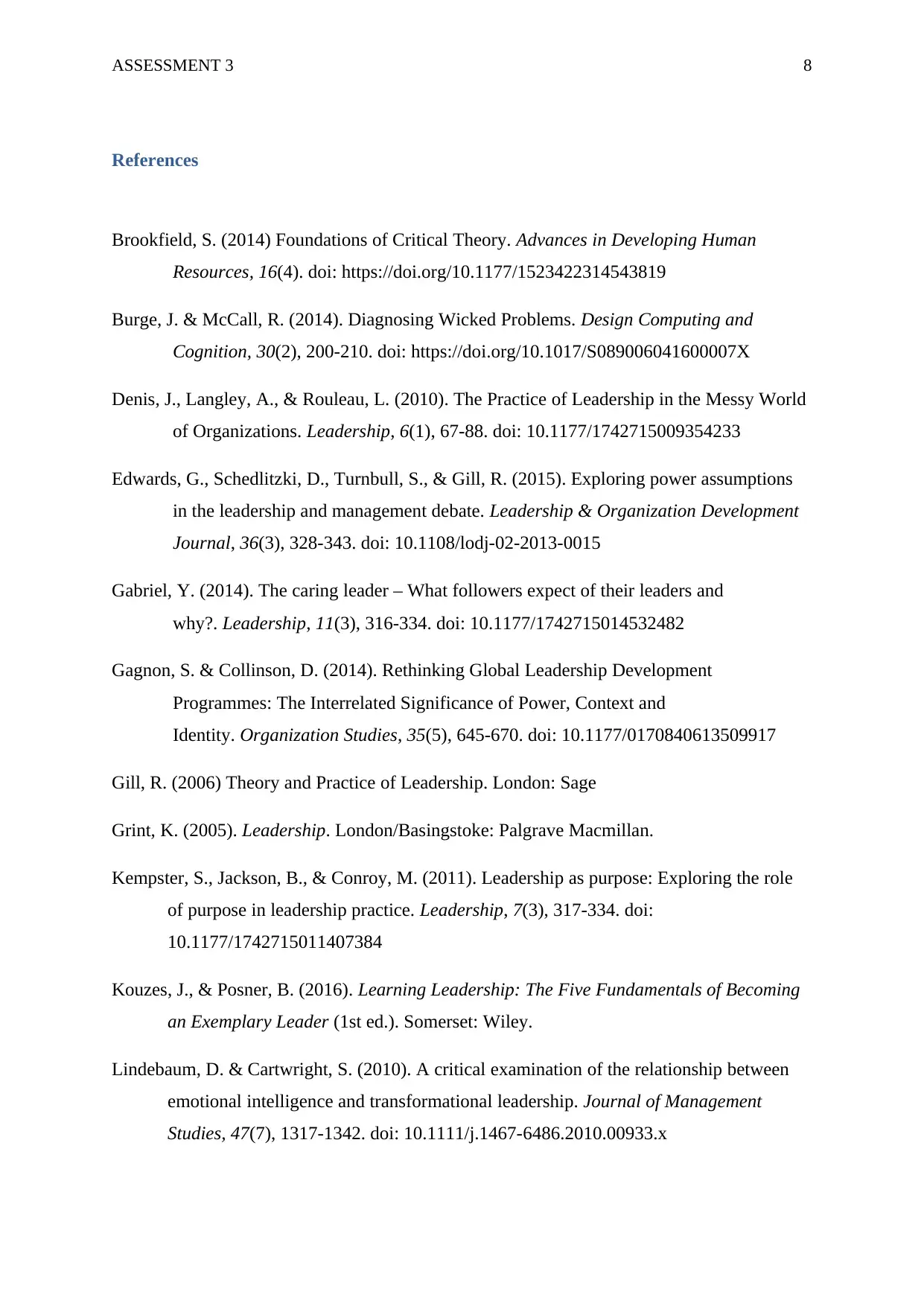
ASSESSMENT 3 8
References
Brookfield, S. (2014) Foundations of Critical Theory. Advances in Developing Human
Resources, 16(4). doi: https://doi.org/10.1177/1523422314543819
Burge, J. & McCall, R. (2014). Diagnosing Wicked Problems. Design Computing and
Cognition, 30(2), 200-210. doi: https://doi.org/10.1017/S089006041600007X
Denis, J., Langley, A., & Rouleau, L. (2010). The Practice of Leadership in the Messy World
of Organizations. Leadership, 6(1), 67-88. doi: 10.1177/1742715009354233
Edwards, G., Schedlitzki, D., Turnbull, S., & Gill, R. (2015). Exploring power assumptions
in the leadership and management debate. Leadership & Organization Development
Journal, 36(3), 328-343. doi: 10.1108/lodj-02-2013-0015
Gabriel, Y. (2014). The caring leader – What followers expect of their leaders and
why?. Leadership, 11(3), 316-334. doi: 10.1177/1742715014532482
Gagnon, S. & Collinson, D. (2014). Rethinking Global Leadership Development
Programmes: The Interrelated Significance of Power, Context and
Identity. Organization Studies, 35(5), 645-670. doi: 10.1177/0170840613509917
Gill, R. (2006) Theory and Practice of Leadership. London: Sage
Grint, K. (2005). Leadership. London/Basingstoke: Palgrave Macmillan.
Kempster, S., Jackson, B., & Conroy, M. (2011). Leadership as purpose: Exploring the role
of purpose in leadership practice. Leadership, 7(3), 317-334. doi:
10.1177/1742715011407384
Kouzes, J., & Posner, B. (2016). Learning Leadership: The Five Fundamentals of Becoming
an Exemplary Leader (1st ed.). Somerset: Wiley.
Lindebaum, D. & Cartwright, S. (2010). A critical examination of the relationship between
emotional intelligence and transformational leadership. Journal of Management
Studies, 47(7), 1317-1342. doi: 10.1111/j.1467-6486.2010.00933.x
References
Brookfield, S. (2014) Foundations of Critical Theory. Advances in Developing Human
Resources, 16(4). doi: https://doi.org/10.1177/1523422314543819
Burge, J. & McCall, R. (2014). Diagnosing Wicked Problems. Design Computing and
Cognition, 30(2), 200-210. doi: https://doi.org/10.1017/S089006041600007X
Denis, J., Langley, A., & Rouleau, L. (2010). The Practice of Leadership in the Messy World
of Organizations. Leadership, 6(1), 67-88. doi: 10.1177/1742715009354233
Edwards, G., Schedlitzki, D., Turnbull, S., & Gill, R. (2015). Exploring power assumptions
in the leadership and management debate. Leadership & Organization Development
Journal, 36(3), 328-343. doi: 10.1108/lodj-02-2013-0015
Gabriel, Y. (2014). The caring leader – What followers expect of their leaders and
why?. Leadership, 11(3), 316-334. doi: 10.1177/1742715014532482
Gagnon, S. & Collinson, D. (2014). Rethinking Global Leadership Development
Programmes: The Interrelated Significance of Power, Context and
Identity. Organization Studies, 35(5), 645-670. doi: 10.1177/0170840613509917
Gill, R. (2006) Theory and Practice of Leadership. London: Sage
Grint, K. (2005). Leadership. London/Basingstoke: Palgrave Macmillan.
Kempster, S., Jackson, B., & Conroy, M. (2011). Leadership as purpose: Exploring the role
of purpose in leadership practice. Leadership, 7(3), 317-334. doi:
10.1177/1742715011407384
Kouzes, J., & Posner, B. (2016). Learning Leadership: The Five Fundamentals of Becoming
an Exemplary Leader (1st ed.). Somerset: Wiley.
Lindebaum, D. & Cartwright, S. (2010). A critical examination of the relationship between
emotional intelligence and transformational leadership. Journal of Management
Studies, 47(7), 1317-1342. doi: 10.1111/j.1467-6486.2010.00933.x
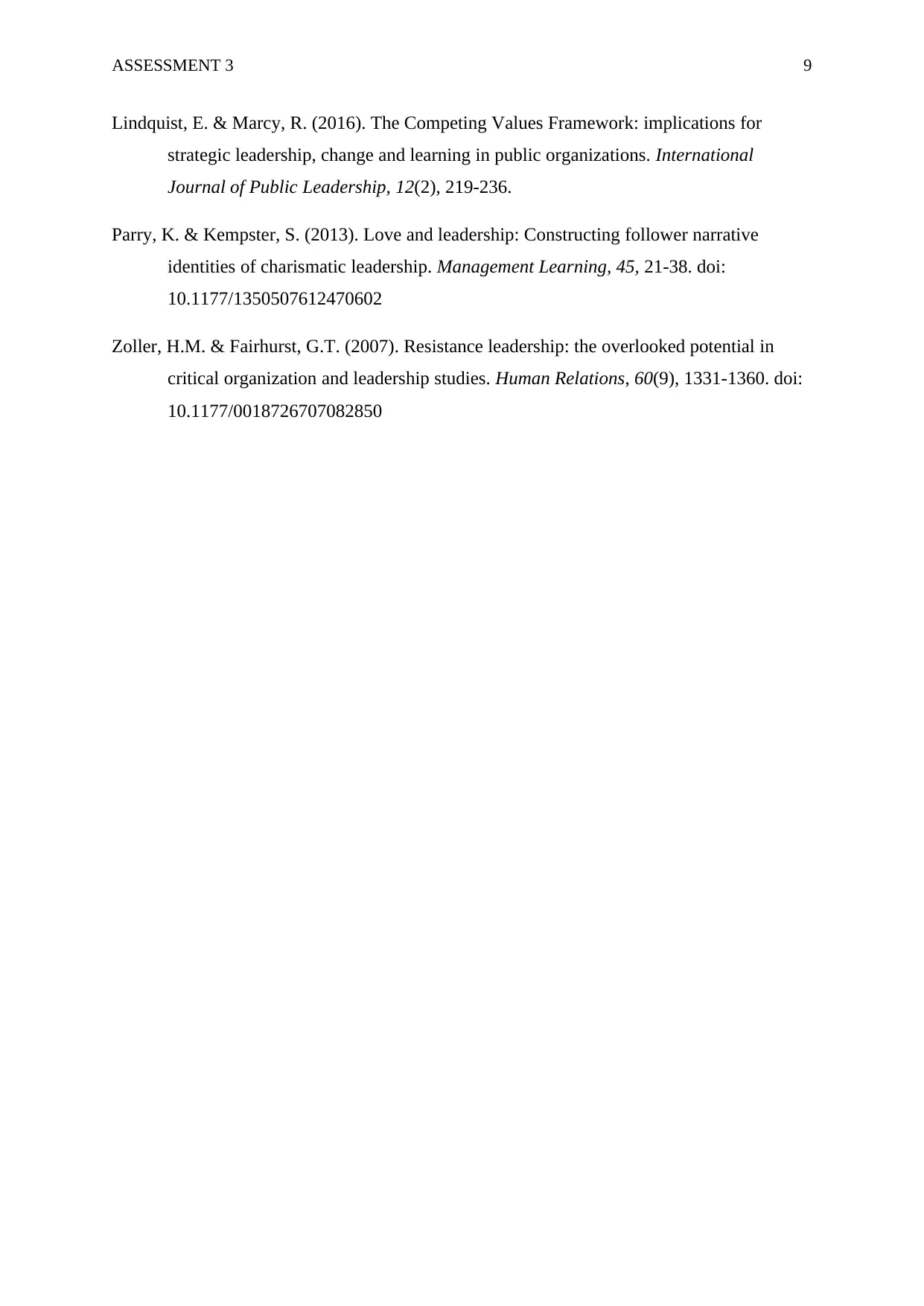
ASSESSMENT 3 9
Lindquist, E. & Marcy, R. (2016). The Competing Values Framework: implications for
strategic leadership, change and learning in public organizations. International
Journal of Public Leadership, 12(2), 219-236.
Parry, K. & Kempster, S. (2013). Love and leadership: Constructing follower narrative
identities of charismatic leadership. Management Learning, 45, 21-38. doi:
10.1177/1350507612470602
Zoller, H.M. & Fairhurst, G.T. (2007). Resistance leadership: the overlooked potential in
critical organization and leadership studies. Human Relations, 60(9), 1331-1360. doi:
10.1177/0018726707082850
Lindquist, E. & Marcy, R. (2016). The Competing Values Framework: implications for
strategic leadership, change and learning in public organizations. International
Journal of Public Leadership, 12(2), 219-236.
Parry, K. & Kempster, S. (2013). Love and leadership: Constructing follower narrative
identities of charismatic leadership. Management Learning, 45, 21-38. doi:
10.1177/1350507612470602
Zoller, H.M. & Fairhurst, G.T. (2007). Resistance leadership: the overlooked potential in
critical organization and leadership studies. Human Relations, 60(9), 1331-1360. doi:
10.1177/0018726707082850
⊘ This is a preview!⊘
Do you want full access?
Subscribe today to unlock all pages.

Trusted by 1+ million students worldwide
1 out of 9
Related Documents
Your All-in-One AI-Powered Toolkit for Academic Success.
+13062052269
info@desklib.com
Available 24*7 on WhatsApp / Email
![[object Object]](/_next/static/media/star-bottom.7253800d.svg)
Unlock your academic potential
Copyright © 2020–2025 A2Z Services. All Rights Reserved. Developed and managed by ZUCOL.





